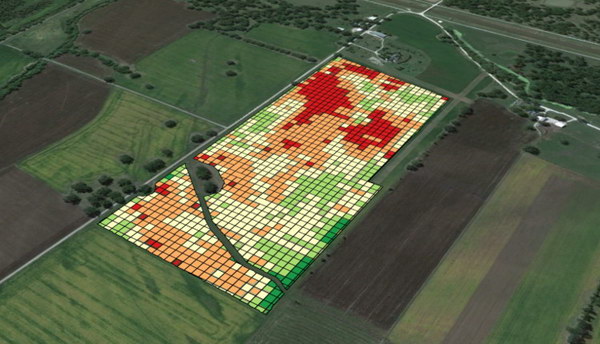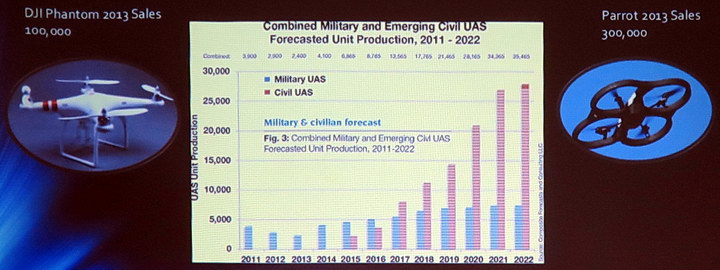Consumer drones for hobbyists and consumer photo/video have claimed much of the drone publicity, especially at consumer-oriented trade shows like CES. But drones have serious professional AV applications as well.

I attended a May 19th event in New York hosted by Stampede and focusing on Pro AV applications. Stampede is a value-added Pro AV distributor in the US, Canada and Latin America. Recently, they have expanded their operations to Europe as well and they have plans for further expansion. The event highlighted companies represented by Stampede and, for example, had projectors from Hitachi, Epson, Christie and Casio on display as well as 4K digital signage panels from LG.
Part of this event was a three part seminar on the use of drones in Pro AV applications. The first seminar was given by Fred Bivetto from Unmanned Vehicle University (UVU). He is a retired Lieutenant Colonel from the US Air Force who flew the B-1 before going to the Air Force test pilot school and getting involved with military drones. The second part of the seminar was presented by Robert Luther, UAV relationship manager for Stampede, on how Stampede can supply and add value to all parts of a drone system, not just the drone itself. The final part of the seminar was presented by Brian Grant on different types of drones, especially ones produced by his company, Yuneec.
Mr. Bivetto discussed applications for drones in the Pro AV space and said UVU has identified over 300 applications. In a single Display Daily, I cannot discuss all 300; in fact in a one hour seminar Mr. Bivetto could not even mention all of them, let alone discuss each one in detail. Some key applications he did discuss include:
- Agriculture is currently the number four commercial use of drones but growth of this segment is rapidly rising. One key agricultural application is to use multi-spectral or hyper-spectral imaging to evaluate crops in the field. This imaging technique can quickly evaluate the health of crops and often identify the cause of poor crop health. Drones can also target pesticides to specific areas of infestation, rather than applying them to entire fields as is done by tractor or manned crop duster aircraft. This restricted application of chemicals is sometimes called “precision agriculture.”
- Bridge inspection can be done more quickly, cheaper and safer than when it is done with humans rappelling over the edges of bridges to look at their undersides. Drones can also be used effectively to inspect things like power lines, pipelines, wind turbines, monuments and virtually anything else that is tedious or difficult to inspect.
- Site Surveys can be done with drones. When equipped with 3D sensors such as LIDAR, they can map sites in detail, sometimes with centimetre-level resolution. This can simplify cut/fill calculations for roads and allow line of sight analysis for things like cell towers or homes. Who wants to build a multi-million dollar home only to find your view is blocked?
- Photography is the best known and most common application of drones. In the professional space, this can range from wedding photography, using a prosumer level of equipment, up to cinema filming using the highest level of professional equipment.
Mr. Bivetto said the drone itself was only one part of a Pro AV drone system, and the least important part at that. Most important, he said was the sensor system carried by the drone. This could be a conventional, multi-spectral or hyper-spectral camera, a LIDAR system or other type of sensor. Larger drones can carry multiple sensors and most commercial drones have the sensor on a gimbal mount so it can be directed independent of the drone itself. The second part of the system was drone control. At the extreme low end, this can be as simple as a BYOD iPhone control system. For commercial drone applications, more complex control systems are normally needed. At the high end of commercial applications, drone control trucks are used, similar to those used for video production in the field. He said the Sprinter van from Mercedes-Benz is often used for this application, although SUVs are also used.
Drone control system built in a Sprinter van for Microdrones. Pictures by MyVan, a division of Mercedes-Benz
In a drone control system like the one shown in the figure, there would normally be at least three people in the van when the drone was operating. The first would be the drone operator (pilot) who would be actually flying the drone. The second would be the sensor operator, who would aim, zoom, start and stop the sensor. This would be a cameraman when the application is sports, cinema or TV production. The third would be a representative of the client. If the drone is used for video or cinema production, this would be the film’s director or his representative.
The third part of a drone system would be the systems to store and analyze the data generated by the drone sensors. For video or cinema production, Mr. Luther said that a wireless version of HDMI was commonly used to relay the content back to the operators in real time. This provides HD/2K resolution. If UHD/4K resolution is required, this HDMI signal serves as a real time proxy and the full UHD/4K resolution is stored on the drone and later downloaded into the post-production editing system.
 Data analysis and display for a precision agriculture application.
Data analysis and display for a precision agriculture application.
The drone itself is the least important part of a professional drone system and typically represents less than 10% of the cost of the complete system. Mr. Grant said that for professional applications, hexacopters are preferred over quadcopters for a couple of reasons. First, they are larger and can therefore carry a heavier sensor payload. Second, when a drone is operating in close proximity to something, for example during a close-up bridge inspection, a propeller may fail if it comes in contact with the object being viewed. For a quadcopter, this means the drone crashes and the expensive sensor package may be destroyed or lost. For a hexacopter, such as his company’s Typhoon/Typhoon H drones, loss of one propeller still allows the drone to continue flying and make a safe and controlled landing.
Due to recent rule changes at the FAA, civil use of drones in the US for commercial purposes has increased rapidly since they were first allowed in 2015. By 2017 this market, in terms of unit volumes, will become larger than the military market. By unit volumes, the hobbyist market is much larger than either the military or the civil market, with popular hobbyist drones selling 100,000 or more units.

The rules on flying drones in the US are complex and everyone who flies one needs to check with the Federal Aviation Administration (FAA). Of course, the rules in other countries are probably equally complex but completely different. The FAA recognizes three different types of operations for drones, which it calls Unmanned Aircraft Systems (UAS):
- Public Operations (Governmental)
- Civil Operations (Non-Governmental)
- Model Aircraft (Hobby or Recreation only)
Exactly which rules and sub-rules apply depends on multiple factors. For example, there are different rules for public operations when the governmental organization is part of the Federal government and when it is a state government or state subdivision, e.g. a local police or fire department.
Most professional AV applications of drones would come under the Civil Operations rules and require a Section 333 Exemption. FAA rules require that all aircraft have an airworthiness certificate and a human pilot but a section 333 exemption waives both of these. This exemption allows flight and commercial operations in low-risk, controlled environments. In general, a Section 333 Exemption requires operation within line-of-sight of the drone. According to Mr. Bivetto, line of sight is loosely defined. Generally anything less than one mile (1.6 Km) is considered line of sight and anything beyond two miles (3.2 Km) is considered beyond line of sight, with a gray area in between. He added that drones operated beyond line of sight are commonly larger, fixed wing systems rather than the short range, battery powered quadcopters or hexacopters consumers and most commercial operators fly.
While the rules may be complex, the benefits of drones compared to manned aircraft can be large, including up to a 10x reduction in cost. This logic is going to drive drones into commercial pro AV applications quickly. Conceivably, the forecasts from UVU presented by Mr Bivetto will prove to be an underestimate. Right now the FAA seems to be the limiting factor in commercial drone usage and they say “Due to the high volume of Section 333 petitions received, we are experiencing delays in processing petitions.”
– Matthew Brennesholtz

